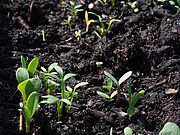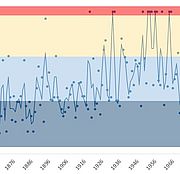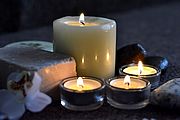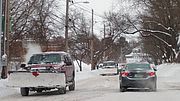Soil isn’t just the dirt we might think of when we wash our hands or take our shoes off at the door. Healthy soil is alive – it’s full of layered root systems, microbial communities, organic matter, worms, bugs, and fungi. It’s an entire ecosystem that powers all life above it. It can sequester carbon, hold water, and support healthy plant life – all of which are vital to turning the tide on climate change. And, most importantly for Lake Champlain’s water quality, soil with just a 1% increase in organic matter in the top six inches can hold over 20,000 gallons of water per acre.
News from Selected Category
Walk, run, hike, bike in the great outdoors. Breath some fresh air, get a little dirty or wet, take in the sunshine – or the rain (or snow), watch the stars. Commune with nature. Getting out into the greenery is known to brighten moods and improve health. To celebrate this year's Earth Day LCC has several ideas for going all out to enjoy and protect our environment!
Nestled between the Adirondacks and the Green Mountains, Lake Champlain is no stranger to cold, snowy winters. Wild ice – ice which forms naturally on lakes and ponds – is a special attribute of northern climes. Ice skating, skiing, show-shoeing, kiting, and fishing all rely on a thick layer of ice forming during the winter months. However, thaws can happen at any time during the ice season, and with climate change winter temperatures are becoming more unpredictable. Learn more about the stages of a thaw on lake ice, and how to stay safe throughout the winter.
LCC is looking to expand our photo stock of pictures for our articles, slideshows, social media, and website, and we need your help to do it! Whether it’s covered in ice or reflecting the summer sky, Lake Champlain is a stunning part of the natural landscape. From a beautiful vista, an unusual water phenomenon, or people exploring the lake, we welcome all of your photos. Submit your pictures of life on and around the water (swimming, fishing, skating, boating, natural history and more!) and help us share images of Lake Champlain in all its moods and magic.
Do you own property along a waterway in New York? Through the “Buffer in a Bag” initiative, New York State Department of Environmental Conservation’s (NYS DEC) Trees for Tribs Program and the NYS Tree Nursery will provide landowners with a free bag of 25 bare-root native trees and shrubs to enhance streamside areas of property. Riparian buffers – the term used to describe these vegetated shoreline zones – are vital to water quality. They allow stormwater to settle out before entering tributaries, which reduces pollution and sedimentation. They also provide wildlife habitat, prevent erosion, and increase the land’s ability to retain floodwaters.
Throughout the winter, Lake Champlain’s vast tracts of ice and snow provide the perfect conditions for snowkiters like Gary Kjelleren. A brand-new sport in the late 1990s, kitesailing (the summer version of snowkiting) quickly took off in popularity. A kitesailer uses a large sail-like kite to catch the wind, while they skim and jump over the water’s surface on a finned water board. Anyone who has spent time on the shores of a large lake or ocean is likely familiar with the colorful, crescent-shaped kites that swoop jauntily through the air, a small human figure skipping along behind them.
On December 19, 2018, LCC member Elizabeth Lee and four friends donned their cross country ski boots even though there was no snow on the ground. There was, however, ice -- wild ice that forms naturally on Lake Champlain. A cold few weeks had frozen some of the southern bays and the river-like strip of the South Lake, so Elizabeth and pals stepped onto Nordic skates and headed to Crown Point in the early morning light.
Knight Point State Park in North Hero was buzzing with people on the day of Vermont’s annual ice fishing festival, which was a particularly sunny Saturday in mid-January. The nice weather drew hundreds to the park in the first hours of the festival. Cars filled the parking lot and spilled out onto either side of the highway, several of them sporting out-of-state plates. People of all ages crowded around the registration table – groups of young college friends, parents dragging sleds full of equipment, toddlers so bundled against the cold that they waddled on the ice like penguins.
One of the best-understood facets of climate change is that global temperatures are rising overall. Since the turn of the 20th century we know that average temperatures have gradually risen every decade, and they will continue to rise more rapidly throughout the 21st century. Due to warming winter temperatures, Lake Champlain does not ice over as often as it did even 20 years ago. The freezeover that happened this month is now a rare and celebrated event. Read...
During winter, when the snow blankets the ground, dog owners may find it tempting to let sleeping dogs lie – and not clean up after them when they poop! After all, whether you’re walking in town or deep in the woods, what’s the harm in kicking a little snow over the stool and letting nature take its course?
If your faucet drips or your toilet runs it can waste over 10,000 gallons a year -- the amount of water in a typical backyard swimming pool. More than one trillion gallons of water are lost annually in the U.S. due to easy-to-fix household leaks. Read...
Teachers at J.J. Flynn Elementary School in Burlington, VT got creative in their World Water Day class project by partnering with Generator Makerspace, a non-profit in Burlington that bridges the intersection of art, science, and technology. With the technical support of Generator Makerspace, students learned to transform their drawings into laser-cut wood mosaics backed by colorful rice paper.
Plastics are everywhere. The stuff has made modern life possible, but more than 40% of plastics are designed for single use. Plastics are showing up in our waterways at an alarming rate, flushed down sinks and toilets in scrubbing agents, wet wipes and sanitary products; spun off as microfibers from clothes in the wash; and carried into waterways by wind and rain.
Read...Maple sugar houses across the states of New York and Vermont are hosting open houses during the weekend of March 23-24 - and festivities will continue in New York the next weekend, March 30-31! Celebrate maple sugaring season in the Champlain watershed by sampling maple products, enjoying pancake breakfasts with fresh syrup, and touring the woods and facilities where the sweet brew is made.
Wednesday, March 27, 2019
3:00 PM - 7:00 PM
Need a little pampering? Treat yourself to Spa Night at O’Brien’s Aveda Institute in Williston on March 27 and protect Lake Champlain at the same time. A $20 advance ticket buys you unlimited mini services including facials, manicures, paraffin dip, facial waxing, braiding, makeup application, and hand massages! All funds raised will be donated to LCC to support our education and outreach programs.
LCC is sorry to report that this event has been cancelled due to low registration. Visit the Champlain Basin Education Initiative (CBEI) website to learn about different events and opportunities in the Lake Champlain watershed.
The Lake Between (Le lac qui nous unit) – is an International Conference designed to bring together academics, business leaders, policy-makers, outdoor enthusiasts, boaters and swimmers, musicians and artists to talk about Lake Champlain. This conference is open to all interested in the past, present and future of our shared lake.
Wednesday April 17, 2019
5:30 - 9:00 PM
Watch students and stylists display their fashion, make-up and design skills and support the Lake Champlain Committee’s work at the same time at the 4/17/19 Catwalk for Water! The annual green carpet event put on by O'Briens Aveda Institute and local Aveda salons will showcase fashion made from recyclable materials and whimsical hair styles following themes of earth, wind, water or fire. Tickets are $15 each. All proceeds from the event will be directed to LCC’s work for clean water.
While the Adirondack region is in the temperate deciduous forest biome, it is also on the edge of several other biomes – the boreal forest, grassland, woodland, and shrubland biomes. A biome is a naturally occurring habitat for certain species. Being on the edge of several could cause the Adirondacks to see shifts in temperature and moisture sooner than the surrounding area.
Otter Creek is the largest wetland in the State of Vermont, stretching 15 miles through Addison and Rutland counties. As the current presidential administration rolls back national wetland protection rules, local groups seek stronger protections for the Otter Creek wetland. This wetland is a valuable resource, not only for its rare and diverse species, but also for its ability to absorb floodwaters. The wetlands and floodplains along the Otter Creek are credited with protecting the town of Middlebury from more than $1.8 million of flood damage during Tropical Storm Irene.
The Vermont angling community voiced concerns with Gov. Phil Scott’s proposal to close the Salisbury Hatchery, one of the state’s five fish hatcheries. This hatchery is the primary source of trout eggs for the state. The hatchery would soon need $13 million in upgrades to meet clean water standards, which figured into the decision to close it.
In its 2019 report card, the Vermont section of the American Society of Civil Engineers (ASCE) gave the state’s infrastructure a “C” – the same grade it earned in the last report card five years ago. The report was broken down into several areas of infrastructure, with stormwater and wastewater infrastructure both receiving a D+, the lowest grades of the report. Civil engineers identified that the state is facing over a billion dollars in investment gaps over the next 20 years for stormwater alone.
The Great Lakes are one of the world’s largest fresh water sources, covering over 750 miles across eight states. However, a recent investigation by Great Lakes Today and American Public Media reveals that the cost of water has doubled, and even tripled, in cities surrounding the lakes. According to this investigation, there have been hundreds of thousands of water shutoffs to homes and businesses since 2010. On top of having to pay the full water bill to restore service, there are often extra fees for shutting it off and turning it back on. For the average individual, losing water service can be the beginning of a downward spiral.
The growing water crisis in America has forced hundreds of thousands to endure weeks, and even months, without water. This crisis is especially dire where you would least expect it – in the Great Lakes region, the most abundant source of fresh water in the country. With the federal government cutting water infrastructure funding, cities have turned to raising water bills to cover the costs of aging infrastructure. These rising costs hit poor families the hardest, with disproportionately high concentrations of water shut-offs in poorer areas, and majority black and Latino neighborhoods, in every city.
According to a report released by the Rhodium Group, a private climate-research firm, carbon dioxide emissions in the U.S. increased by roughly 3.4% in 2018 – this after three years of decline. The report points to a particularly cold winter and economic growth as the main contributors. While this appears to pit climate change reductions against economic growth, it’s entirely possible to lower emissions while improving the economy. Climate change is a leading contributor to many expensive environmental issues, including increased cyanobacteria blooms, stormwater runoff, and other water quality concerns.
In his January 24, 2019 Budget Address, Vermont Governor Phil Scott proposed using a portion of the Estate Tax to fund water projects. We applaud the Governor’s commitment to long-term clean water funding, but we are concerned with the proposal he advanced because the tax is variable and moves around existing funds in the state budget. For several years LCC has been working as a member of the Vermont Water Caucus to advance state environmental policy. Read...
After winter storm Harper dumped over two feet of snow in parts of the Lake Champlain watershed, followed by more precipitation in the form of freezing rain, the roads were slick from both snow and ice. The few cars braving the weather might find themselves outnumbered by plows, earthmovers, and dump trucks. While the sudden appearance of plows and clear roads after a storm may seem like magic, the snow removal process takes careful planning. Even before the Lake Champlain basin’s heavy snow comes down, or freezing rain coats the roads, municipalities are already swinging into action.
In the midst of winter changes there is a lake phenomenon that seems more at home in the extreme cold of the arctic than familiar Lake Champlain. Commonly called ice volcanoes, this phenomenon is unique to large northern lakes and oceans, where powerful waves send “eruptions” of water through the ice.
100,000 years ago, winter in the Champlain valley was a lot longer. The last glaciers of the ice age filled the Green and Adirondack Mountains, carrying vast amounts of earth that scraped the land like sandpaper, deepening the valley that would one day hold Lake Champlain.
Winters on Lake Champlain are known for their long hours of darkness. As the sun sets earlier each afternoon, and rises later each morning, those who have settled in this valley may begin to feel the days blend together into one long winter’s night.




























